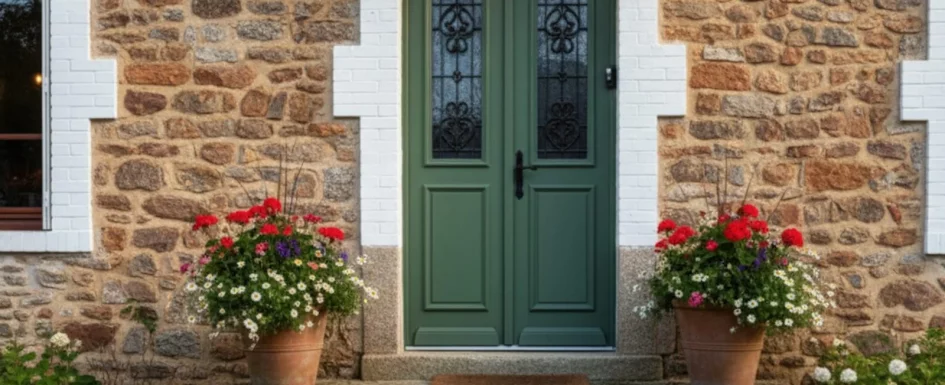
Welcome to Pétale de Carreaux, a blog dedicated to architecture, interior design, real estate and renovation, run by architects and design professionals. The front door is often the first element people notice in a renovation. It reflects the home’s character while ensuring comfort and security. So, which front door should you choose for a renovated home? Here’s our expert advice to help you find the ideal model for your façade and lifestyle.
Balancing authenticity and performance in renovation
Renovating a house is about finding the right balance between the charm of the past and today’s technical requirements. The front door should integrate naturally with the existing architecture while offering the expected performance: thermal insulation, resistance and security.
For a traditional home, a wooden door remains a timeless choice. Warm, authentic and customizable, wood pairs beautifully with historic façades. It can be fitted with multipoint locks or laminated glazing to enhance security and meet insurance requirements. Wood can be stained, painted or varnished to suit different aesthetics.
Architect’s insight: On one project, a metallic front door looked out of place against a renovated stone façade. By reusing original decorative elements in the new door, we achieved a cohesive and stunning result that transformed the house’s entrance.
For a more contemporary renovation, aluminum or wood-aluminum hybrid doors offer great flexibility in shapes and colors. Aluminum is lightweight and durable, ideal for clean lines and custom finishes, while the hybrid version combines the warmth of wood inside with the strength of aluminum outside. It’s a perfect way to combine style and performance while upgrading or replacing existing frames and joinery.
Key criteria for choosing the right front door
1. Thermal and acoustic performance when replacing joinery
A well-insulated front door improves overall comfort. Check the Uw value (thermal insulation) and Rw value (sound insulation). A high-performing door reduces heat loss and outside noise, while meeting modern standards.

2. Aesthetic and architectural coherence
A successful front door blends with the building’s architecture rather than dominating it. Its style, color, and texture should harmonize with both the façade materials and interior mood. Powder-coated finishes, frosted glass or wrought-iron details are great ways to personalize the door while maintaining overall design harmony.
Architect’s tip: Many clients hesitate between a classic wooden door and a sleek aluminum version. We often price both options and compare them in terms of aesthetic and functional impact to help them make confident, informed decisions.
A front door designed to last
Choosing the right front door for a renovated home means investing in continuity and coherence. Whether in wood, aluminum or hybrid, it should reflect the home’s identity while ensuring comfort and security. A well-designed front door creates a seamless transition between indoor and outdoor spaces and elevates the renovation.
Regulatory note: Always check local building regulations. Exterior changes, new surfaces or modifications often require a simple declaration. Some municipalities are very strict — we’ve even seen municipal police intervene for unauthorized door replacements.
For more details, check out our complete front door guide on materials, insulation, design and architectural advice.
See you soon on Pétale de Carreaux
